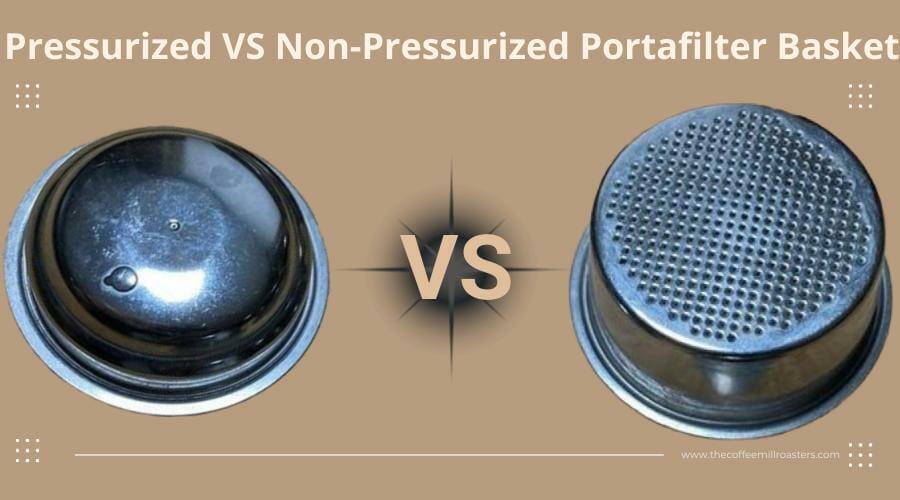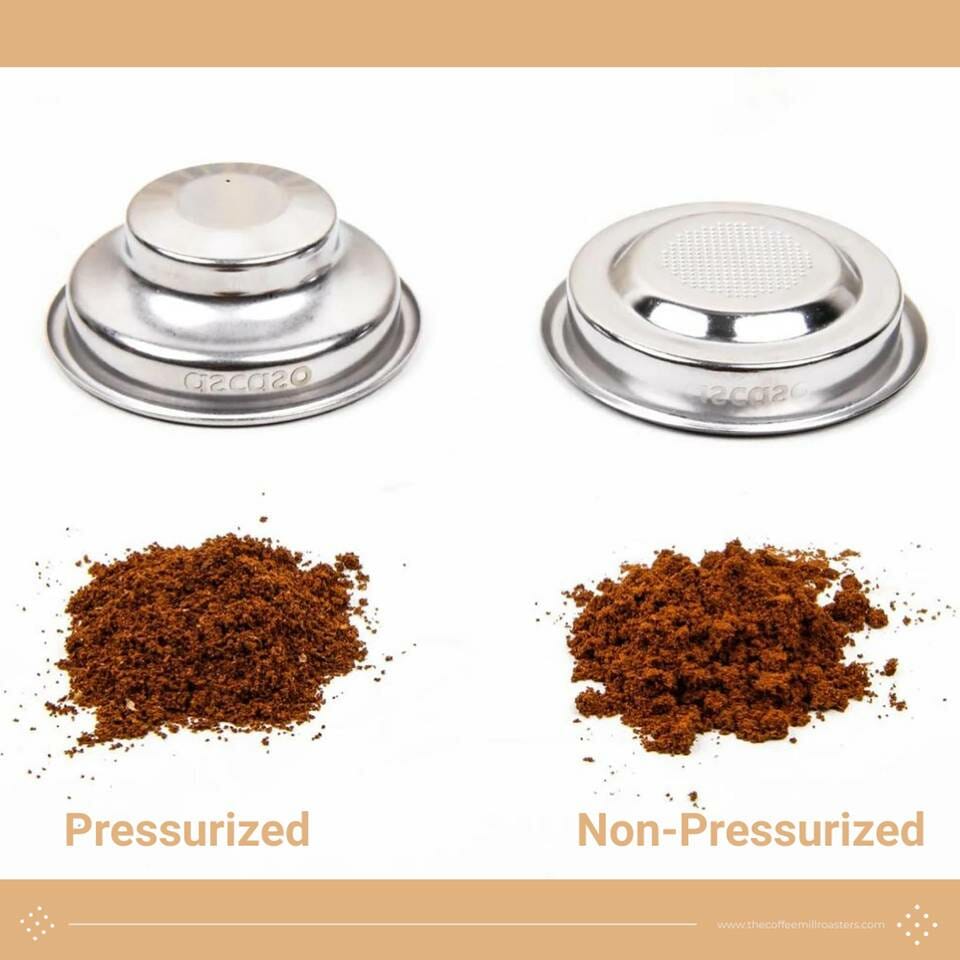A portafilter is a must-have accessory when making espresso. If you own a high-quality portafilter, it can assist you in providing perfect beverages. It is an item that can be classified in several ways based on its size, shape, and more.
But, many espresso lovers commonly want to know about the difference between pressurized and non-pressurized portafilters. Though both have a similar appearance, they are entirely different in operation..
This post will be interesting if you have always wanted to know about pressurized vs. non-pressurized portafilters. Keep reading to learn more.
A Quick Introduction to Both Types of Portafilters:
| Feature | Pressurized Portafilter | Non-Pressurized Portafilter |
|---|---|---|
| Purpose | Designed to create a crema regardless of grind size or tamping | Requires proper grind size and tamping to create crema |
| Espresso quality | Produces a consistent but potentially less flavorful espresso | Can produce a more flavorful espresso with proper technique |
| Learning curve | Easier to use and suitable for beginners | Steeper learning curve and recommended for experienced baristas |
| Cleaning | Easier to clean due to fewer parts | More complex and may require more frequent cleaning |
| Price | Generally less expensive than non-pressurized portafilters | Generally more expensive than pressurized portafilters |
| Suitability | Suitable for home use and beginner baristas | Recommended for experienced baristas and coffee enthusiasts |
| Flexibility | May require specific coffee blends and may limit customization options | Offers greater flexibility in choosing coffee blends and allows for more customization options |
We are going to begin the comparison from the basics. Let’s start with the introduction.

Pressurized Portafilter:
It is a particular type of portafilter, which is also called dual wall portafilter due to its double baskets. A pressurized portafilter builds extra pressure while pulling out espresso shots. That’s why it is a good item for users who often choose poor grind size and have little knowledge about accurate dosing and tamping.
An excellent thing about a pressurized portafilter is that you can use it with various coffee grinds. If you have a pressurized portafilter, using even pre-ground coffee to make espresso will not be much more challenging. It also works fine with the coarse grind to brew espresso instead of fine grind.

Non-Pressurized Portafilters:
A non-pressurized portafilter is – the regular portafilter we often see and has a single basket with several holes at the bottom. Though using a non-pressurized portafilter requires expertise, it delivers a professional outcome. A non-pressurized portafilter produces a richer espresso taste comparing a pressurized portafilter. However, using one requires a finer grind and accurate pressure for the best result.
How Are Pressurized and Non-Pressurized Portafilters Different?
There are several differences between these two types of portafilters. Here we mentioned the major differences.
Structural Differences:
A pressurized and non-pressurized portafilter can easily be identified by looking at their structures. As mentioned above, a pressurized portafilter has two walls, whereas a non-pressurized portafilter comes with a single wall.
Another big difference between them is their number of holes at the bottom. A regular or non-pressurized portafilter has multiple holes. On the other hand, the inner basket of a pressurized portafilter has many holes. But, the lower basket has only one hole at the bottom.

The Way of Extraction:
Along with the formation, both types of portafilters have different working methods. A pressurized portafilter has two baskets, including an inner and an outer. The inner basket has multiple holes, whereas the outer basket has a single hole only.
When an espresso machine passes water through the coffee ground, the extracted espresso goes into the holding area and creates extreme pressure. This pressure forces espresso to go through the single hole of the outer basket.
In contrast, a non-pressurized portafilter has a single basket with several holes at its bottom. Besides, this one has no holding chamber. So, when an espresso machine passes water with high pressure through the coffee ground, the espresso directly goes through those holes and drops into cups.
Read: Our Recommended Tamping Station
Quality of Espresso:
If you have used both portafilter types, you will notice significant differences in the quality of the espresso. A pressurized portafilter makes very rich crema, making beginners happy with its delicious appearance. Many coffee shops also use this technique to make espresso look gorgeous. But, your espresso may have a watery taste due to over-purifying.
In contrast, a non-pressurized portafilter will produce espresso with rich flavor. It happens because the coffee ground in the portafilter gets accurate water pressure created by the espresso machine. It is a big reason why professionals commonly use non-pressurized portafilters.
The Convenience of Using:
A pressurized portafilter is easy to use; even you can make excellent espresso with basic brewing knowledge. This portafilter also allows users to use pre-ground coffee, which reduces the hassle of grinding.
Another plus point of using a pressurized portafilter is that the coffee ground needs no accurate tamping. But, you may face difficulty while cleaning the portafilter. Besides, pressurized portafilters often get jammed due to the single hole.
On the other hand, non-pressurized portafilter delivers high-quality espresso. If you have advanced knowledge about grind size and tamping, you can extract the best beverage using it. Cleaning a non-pressurized portafilter is pretty easier. But, this portafilter will require a powerful espresso machine that can create optimal pressure for the perfect espresso.
Read: Bottomless Vs. Normal Portafilter
Questions May Pop-up in Your Mind:
The quality of espresso depends on several factors. So, a pressurized portafilter alone will not magically improve your espresso quality. However, it helps generate more crema, a crucial characteristic of high-quality espresso.
Tamping becomes a less important step in making espresso when using a pressurized portafilter. It is because this portafilter automatically corrects espresso tamping and channeling issues.
You may think that a pressurized portafilter blocks the normal water flow of an espresso machine. However, the truth is – using a pressurized portafilter is perfectly okay for an espresso machine.
Read: Best Bottomless Portafilter
SO, Which One Should You Pick?
Finally, we have reached the end of this debate. If you are still confused about which to choose, this section will clarify it.
If you are a beginner, go for a pressurized portafilter because it automatically fixes common extraction issues. It is an excellent item for users with espresso machines struggling with generating sufficient water pressure. Also, you can choose it if your grinder cannot produce a finer grind; or if you prefer to use pre-ground coffee for espresso.
In contrast, a non-pressurized portafilter is the best option when your espresso machine has no pressure issues. If you are good at preparing finer grind and tamping, a non-pressurized one will consistently deliver flavorful espresso.